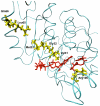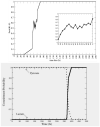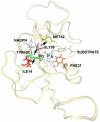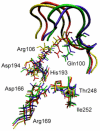Protein dynamics and the enzymatic reaction coordinate
- PMID: 23508766
- PMCID: PMC4346281
- DOI: 10.1007/128_2012_412
Protein dynamics and the enzymatic reaction coordinate
Abstract
This chapter discusses progress over the past 15 years in understanding the role of protein dynamics in enzymatically catalyzed chemical reactions. Research has shown that protein motion on all timescales from femtoseconds to milliseconds can contribute to function, and in particular in some enzymes there are sub-picosecond motions, on the same timescale as barrier passage, the couple directly to chemical transformation, and are thus part of the reaction coordinate. Approaches such as transition path sampling and committor analysis have greatly enhanced our understanding of these processes.
Figures








Similar articles
-
Role of dynamics in enzyme catalysis: substantial versus semantic controversies.Acc Chem Res. 2015 Feb 17;48(2):466-73. doi: 10.1021/ar500322s. Epub 2014 Dec 24. Acc Chem Res. 2015. PMID: 25539442 Free PMC article. Review.
-
Atomistic description of the relationship between protein dynamics and catalysis with transition path sampling.Methods Enzymol. 2023;685:319-340. doi: 10.1016/bs.mie.2023.03.005. Epub 2023 Apr 19. Methods Enzymol. 2023. PMID: 37245906 Free PMC article. Review.
-
Enzymatic transition states and dynamic motion in barrier crossing.Nat Chem Biol. 2009 Aug;5(8):551-8. doi: 10.1038/nchembio.202. Nat Chem Biol. 2009. PMID: 19620996 Free PMC article.
-
Preorganization and protein dynamics in enzyme catalysis.Chem Rec. 2002;2(1):24-36. doi: 10.1002/tcr.10009. Chem Rec. 2002. PMID: 11933259 Review.
-
Connecting Conformational Motions to Rapid Dynamics in Human Purine Nucleoside Phosphorylase.J Phys Chem B. 2023 Jan 12;127(1):144-150. doi: 10.1021/acs.jpcb.2c07243. Epub 2022 Dec 20. J Phys Chem B. 2023. PMID: 36538016 Free PMC article.
Cited by
-
Engineered control of enzyme structural dynamics and function.Protein Sci. 2018 Apr;27(4):825-838. doi: 10.1002/pro.3379. Epub 2018 Feb 16. Protein Sci. 2018. PMID: 29380452 Free PMC article. Review.
-
Protein Mass Effects on Formate Dehydrogenase.J Am Chem Soc. 2017 Dec 6;139(48):17405-17413. doi: 10.1021/jacs.7b08359. Epub 2017 Nov 27. J Am Chem Soc. 2017. PMID: 29083897 Free PMC article.
-
Dependence of crystallographic atomic displacement parameters on temperature (25-150 K) for complexes of horse liver alcohol dehydrogenase.Acta Crystallogr D Struct Biol. 2022 Oct 1;78(Pt 10):1221-1234. doi: 10.1107/S2059798322008361. Epub 2022 Sep 27. Acta Crystallogr D Struct Biol. 2022. PMID: 36189742 Free PMC article.
-
Oscillatory Active-site Motions Correlate with Kinetic Isotope Effects in Formate Dehydrogenase.ACS Catal. 2019 Dec 6;9(12):11199-11206. doi: 10.1021/acscatal.9b03345. Epub 2019 Oct 25. ACS Catal. 2019. PMID: 33996196 Free PMC article.
-
Effects of cavities at the nicotinamide binding site of liver alcohol dehydrogenase on structure, dynamics and catalysis.Biochemistry. 2014 Feb 11;53(5):881-94. doi: 10.1021/bi401583f. Epub 2014 Jan 30. Biochemistry. 2014. PMID: 24437493 Free PMC article.
References
-
- Austin RH, Beeson KW, Eisenstein L, Frauenfe1der H, Gunsalus IC. Biochemistry. 1975;14:5355. - PubMed
-
- Agmon N, Hopfield J. J. Chern. Phys. 1983;79:2042.
-
- Brooks B, Bruccoleri R, Olafson B, States D, Swaminathan S, Karplus M. J. Comp. Chem. 1983;4:187–217.
-
- Gao J, Amara P, Alhambra C, Field M. J. Phys. Chem. A. 1998;102:4714.
Publication types
MeSH terms
Substances
Grants and funding
LinkOut - more resources
Full Text Sources
Other Literature Sources
Miscellaneous

